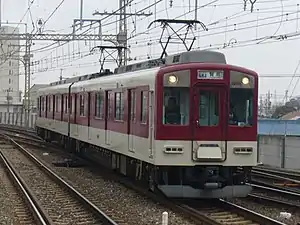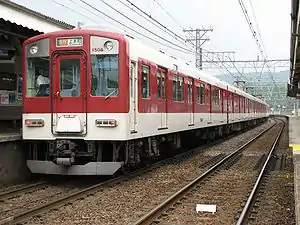
The Kintetsu 1400 series (近鉄1400系, Kintetsu 1400-kei) is a commuter electric multiple unit (EMU) train type operated by the private railway operator Kintetsu Railway since 1981 on many of its commuter lines in the Kansai area of Japan.
Design
First introduced in 1984, the design is based on the earlier Kintetsu 3000 series commuter train, also manufactured by Kinki Sharyo.
All trains are equipped with longitudinal seating and automatic announcements in both Japanese and English. All trainsets run on standard gauge 1,435 mm (4 ft 8+1⁄2 in), except for the 6600 series which run on 1,067 mm (3 ft 6 in) gauge on the Minami Osaka Line.
Variants
- 1200 series (2nd Generation): 4-car sets primarily used on the Nagoya Line
- 1201 series: 2-car sets primarily used on the Nagoya Line equipped for wanman driver-only operation
- 1400 series: 4-car sets primarily used on the Nagoya Line
- 2050 series: 3-car sets primarily used on the Nagoya Line
- 6600 series: 2-car narrow-gauge sets primarily used on the Minami Osaka Line network
1200 series (2nd generation)
| 1200 series (2nd generation) | |
|---|---|
 Set 1211 on the Nagoya Line | |
| In service | 1984–present |
| Manufacturer | Kinki Sharyo |
| Constructed | 1984 |
| Refurbished | 2003–2004 |
| Number built | 11 sets (24 vehicles) |
| Number in service | 1 set (4 vehicles) |
| Formation | 4 cars per trainset |
| Fleet numbers | 1211 |
| Operators | Kintetsu Railway |
| Depots |
|
| Lines served | |
| Specifications | |
| Car length | 20.72 m (67 ft 11+3⁄4 in) |
| Width | 2,740 mm (8 ft 11+7⁄8 in) |
| Height | 4,150 mm (13 ft 7+3⁄8 in) M-car 4,055 mm (13 ft 3+5⁄8 in) T-car |
| Doors | 4 pairs per side |
| Maximum speed | 110 km/h (68.4 mph) |
| Traction system | Mitsubishi Electric |
| Power output | 160 kW (215 hp) per motor |
| Acceleration | 3.3 km/(h⋅s) (2.1 mph/s) |
| Deceleration | 3.5 km/(h⋅s) (2.2 mph/s)(service) 4.5 km/(h⋅s) (2.8 mph/s)(emergency) |
| Electric system(s) | 1,500 V DC Overhead wire |
| Current collector(s) | Pantograph |
| Bogies | KD-66/KD88 |
| Multiple working | 2410 Series 2430 Series |
| Track gauge | 1,435 mm (4 ft 8+1⁄2 in) |
The 1200 series is the final variant in the 1400 series family. Originally, 11 four-car sets were built in 1982, but in 1983, all but one of the sets were converted into the 1201 series.[2]
Formations
The sole remaining set is formed as follows.[2]
| Car No. | 1 | 2 | 3 | 4 |
|---|---|---|---|---|
| Numbering | Ku 2590 | Mo 2450 | Sa 1380 | Mo 1200 |
Interior
Like all variants, seating consists of longitudinal seating throughout.
 1201 series interior
1201 series interior
1201 series
| 1201 series | |
|---|---|
 Set 1201 at Uziyamada station | |
| In service | 1982–present |
| Manufacturer | Kinki Sharyo |
| Replaced | 2250 series |
| Constructed | 1982 |
| Refurbished | 2000–2003 |
| Number built | 10 sets (20 vehicles) |
| Number in service | 10 sets (20 vehicles) |
| Formation | 2 cars per trainset |
| Fleet numbers | 1201–1210 |
| Operators | Kintetsu Railway |
| Depots |
|
| Lines served | |
| Specifications | |
| Car length | 20,720 mm (67 ft 11+3⁄4 in) |
| Width | 2,740 mm (8 ft 11+7⁄8 in) |
| Height | 4,150 mm (13 ft 7+3⁄8 in) M-car 4,055 mm (13 ft 3+5⁄8 in) T-car |
| Doors | 4 pairs per side |
| Maximum speed | 110 km/h (68.4 mph) |
| Traction system | Mitsubishi Electric |
| Power output | 160 kW (215 hp) per motor |
| Acceleration | 3.3 km/(h⋅s) (2.1 mph/s) |
| Deceleration | 3.5 km/(h⋅s) (2.2 mph/s) 4.5 km/(h⋅s) (2.8 mph/s)(emergency) |
| Electric system(s) | 1,500 V DC Overhead wire |
| Current collector(s) | Pantograph |
| Bogies | KD-78/KD88 |
| Track gauge | 1,435 mm (4 ft 8+1⁄2 in) |
The 1201 series are former 1200 series sets that were converted to ten 2-car sets and re-fitted for wanman (driver-only) operation.[2] Only one set, the one listed above remained a 1200 series.
Formations
Sets are formed as follows.[2]
| Car No. | 1 | 2 |
|---|---|---|
| Numbering | Ku 1301 | Mo 1201 |
Interior
As it was before the conversion, and like the other models, seating consists of longitudinal seating throughout.
 1201 series interior
1201 series interior
1400 series
| 1400 series | |
|---|---|
 A 1400 series bound for Uehommachi station | |
| In service | 1981–present |
| Manufacturer | Kinki Sharyo |
| Constructed | 1981 |
| Entered service | 1981 |
| Refurbished | 2000–2003 |
| Number built | 4 sets (16 vehicles) |
| Number in service | 4 sets (16 vehicles) |
| Formation | 4 cars per trainset |
| Fleet numbers | 1501–1507 (odd) |
| Operators | Kintetsu Railway |
| Depots |
|
| Lines served | |
| Specifications | |
| Car length | 20,720 mm (67 ft 11+3⁄4 in) |
| Width | 2,740 mm (8 ft 11+7⁄8 in) |
| Height | 4,150 mm (13 ft 7+3⁄8 in) M-car 4,055 mm (13 ft 3+5⁄8 in) T-car |
| Doors | 4 pairs per side |
| Maximum speed | 110 km/h (68.4 mph) |
| Traction system | Mitsubishi Electric |
| Power output | 160 kW (215 hp) per motor |
| Acceleration | 3.3 km/(h⋅s) (2.1 mph/s) |
| Deceleration | 3.5 km/(h⋅s) (2.2 mph/s)(service) 4.5 km/(h⋅s) (2.8 mph/s) (emergency) |
| Electric system(s) | 1,500 V DC Overhead wire |
| Current collector(s) | Pantograph |
| Bogies | KD-78/KD88 |
| Track gauge | 1,435 mm (4 ft 8+1⁄2 in) |
The 1400 series is the original variant, having first appeared in February 1981.[3] Four 4-car sets were built.
Formations
The four-car sets are formed as follows.
| Car No. | 1 | 2 | 3 | 4 |
|---|---|---|---|---|
| Designation | Ku 1500 | Mo 1400 | Ku 1500 | |
Interior
As with the other variants, seating consists of longitudinal seating throughout.[1]
2050 series
| 2050 series | |
|---|---|
 A 2050 series at Shiohama Station | |
| In service | 1983–present |
| Manufacturer | Kinki Sharyo |
| Constructed | 1983 |
| Entered service | 1983 |
| Refurbished | 2002 |
| Number built | 2 sets (6 vehicles) |
| Number in service | 2 sets (6 vehicles) |
| Formation | 3 cars per trainset |
| Fleet numbers | 2051–2053 (odd) |
| Operators | Kintetsu Railway |
| Depots |
|
| Lines served | |
| Specifications | |
| Car length | 20,720 mm (67 ft 11+3⁄4 in) |
| Width | 2,740 mm (8 ft 11+7⁄8 in) |
| Height | 4,150 mm (13 ft 7+3⁄8 in) M-car 4,055 mm (13 ft 3+5⁄8 in) T-car |
| Doors | 4 pairs per side |
| Maximum speed | 110 km/h (68.4 mph) |
| Traction system | Mitsubishi Electric |
| Power output | 160 kW (215 hp) per motor |
| Acceleration | 3.3 km/(h⋅s) (2.1 mph/s) |
| Deceleration | 3.5 km/(h⋅s) (2.2 mph/s)(service) 4.5 km/(h⋅s) (2.8 mph/s)(emergency) |
| Electric system(s) | 1,500 V DC Overhead wire |
| Current collector(s) | Pantograph |
| Bogies | KD-78/KD88 |
| Track gauge | 1,435 mm (4 ft 8+1⁄2 in) |
Two three-car sets were delivered in 1983 designated as the 2050 series.
Formations
The sites are formed as follows.
| Car No. | 1 | 2 | 3 |
|---|---|---|---|
| Designation | Ku 2150 | Mo 2050 | Mo 2050 |
Interior
Seating consists of longitudinal seating throughout, like all of the other variants. Some cars have onboard toilets.
Refurbishment
In 2002, the sets were refurbished and modeled similar to the 1200 series.[4] A second renovation occurred around 2020.
6600 series
| 6600 series | |
|---|---|
 A 6600 series at Koboreguchi Station | |
| In service | 1983–present |
| Manufacturer | Kinki Sharyo |
| Replaced | 6800 series. 6411 series |
| Constructed | 1983 |
| Entered service | 1983 |
| Refurbished | 2001–2003 |
| Number built | 4 sets (8 vehicles) |
| Number in service | 4 sets (8 vehicles) |
| Formation | 2 cars per trainset |
| Fleet numbers | 6601–6604 |
| Operators | Kintetsu Railway |
| Depots |
|
| Lines served | |
| Specifications | |
| Car length | 20,720 mm (67 ft 11+3⁄4 in) |
| Width | 2,740 mm (8 ft 11+7⁄8 in) |
| Height | 4,150 mm (13 ft 7+3⁄8 in) M-car 4,055 mm (13 ft 3+5⁄8 in) T-car |
| Doors | 4 pairs per side |
| Maximum speed | 100 km/h (62.1 mph) |
| Traction system | Mitsubishi Electric |
| Power output | 150 kW (201 hp) per motor |
| Acceleration | 3.3 km/(h⋅s) (2.1 mph/s) |
| Deceleration | 3.5 km/(h⋅s) (2.2 mph/s)(service) 4.5 km/(h⋅s) (2.8 mph/s)(emergency) |
| Electric system(s) | 1,500 V DC Overhead wire |
| Current collector(s) | Pantograph |
| Bogies | KD-90/KD-90-A |
| Multiple working | 6820 series |
| Track gauge | 1,067 mm (3 ft 6 in) |
Four two-car sets were delivered in 1983 designated as the 6600 series.[4]
Operations
The sets are operated on the 1,067 mm (3 ft 6 in) Minami Osaka Line network. However, they are not allowed on the Domyoji Line as they are not equipped for wanman driver-only operation.[5]
Formation
The sets are formed as follows. Both cars are motorized.
| Car No. | 1 | 2 |
|---|---|---|
| Numbering | 6700 | 6600 |
Interior
Seating consists of longitudinal seating throughout, like the standard gauge variants.
References
- 1 2 3 4 5 6 "大手私鉄車両ファイル2020 車両配置表" [Major Railway Company Vehicle File 2020 Vehicle Layout Table]. 鉄道ファン (in Japanese). 59. August 2019 – via 交友社.
- 1 2 3 4 飯島, 巌 (2002). 復刻版 私鉄の車両13 近畿日本鉄道II [Kinki Nihon Railway 2, Commuter Vehicle and More] (in Japanese). Japan: ネコ・パブリッシング. p. 12. ISBN 978-4873662961.
- ↑ 諸河, 久 (1998). 日本の私鉄 近鉄2 (in Japanese). Japan: 保育社. p. 38. ISBN 978-4586509058.
- 1 2 三好, 好三 (2016). 近鉄電車 [Kintetsu Railway] (in Japanese). Japan: JTBパブリッシング. p. 173. ASIN B06X9G6SQK.
- ↑ 近畿日本鉄道 完全データ DVD BOOK [Kinki Nippon Railway Complete Data DVD BOOK] (in Japanese). Japan: メディアックス. 2011. p. 64. ISBN 978-4862013934.
